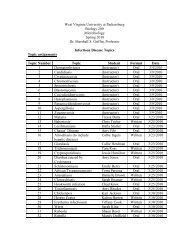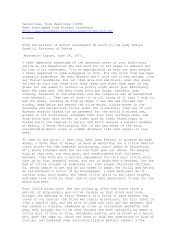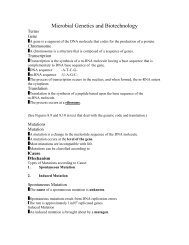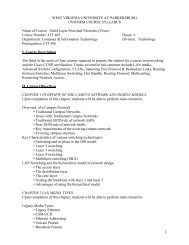Candidiasis, Cryptococcosis, Chromomycosis, and Sporotrichosis
Candidiasis, Cryptococcosis, Chromomycosis, and Sporotrichosis
Candidiasis, Cryptococcosis, Chromomycosis, and Sporotrichosis
Create successful ePaper yourself
Turn your PDF publications into a flip-book with our unique Google optimized e-Paper software.
<strong>C<strong>and</strong>idiasis</strong><br />
<strong>C<strong>and</strong>idiasis</strong>, <strong>Cryptococcosis</strong>, <strong>Chromomycosis</strong>, <strong>and</strong><br />
<strong>Sporotrichosis</strong><br />
Name of Disease -- <strong>C<strong>and</strong>idiasis</strong> (C<strong>and</strong>idosis, Moniliasis,<br />
Thrush (mucocutaneous c<strong>and</strong>idiasis))<br />
Causative agent -- C<strong>and</strong>ida albicans <strong>and</strong> other species of C<strong>and</strong>ida<br />
Classification -- yeast-like fungi<br />
The disease is more common in neonates, the elderly, <strong>and</strong> immunocompromised/<br />
immunosuppressed/debilitated individuals<br />
Mode of Transmission<br />
Usually non-communicable since the organisms are normally present in low numbers on<br />
the mucous membrane surfaces<br />
May in some cases be acquired from contact with secretions from another individual<br />
Neonates acquire the organisms from the mother during passage through the birth canal.<br />
Thrush (Mucocutaneous form)<br />
A mycosis confined to the superficial layers of the skin <strong>and</strong>/or mucous membranes.<br />
Lesions -- red macules or ulcers on the skin with gray curdy patches on the mucous<br />
membrane surface.<br />
Ulcers or pseudomembranes may form on the esophagus, stomach, or intestine.<br />
Disseminated form<br />
Organisms may spread through the blood to internal organs such as the heart, liver,<br />
spleen, kidney, lungs, meninges, brain, etc.<br />
Tissues are invaded by the pseudohyphae of the organism producing tissue inflammation.
Immunization <strong>and</strong> Treatment<br />
Immunization -- none<br />
Treatment --<br />
mucocutaneous infections - oral or topical Nystatin<br />
systemic infections - oral Ketoconazole or I.V. Amphotericin B<br />
<strong>Cryptococcosis</strong><br />
Name of the Disease -- <strong>Cryptococcosis</strong><br />
Causative Agent -- Cryptococcus neoformans<br />
Classification of Causative Agent -- Fungus<br />
Description -- Encapsulated, yeast-like fungus<br />
Mode of Transmission<br />
Inhalation of spores<br />
Spores are associated with droppings of pigeons <strong>and</strong> bats.<br />
Disease Progression<br />
Mild self-limiting pulmonary infection is the most common<br />
Debilitated individuals are susceptible to dissemination<br />
Dissemination through the blood may result in a chronic type of meningitis<br />
Immunization <strong>and</strong> Treatment<br />
Immunization -- none<br />
Page 2<br />
Treatment -- Amphotericin B (Fungizone®) administered IV sometimes in combination<br />
with 5-fluorocytosine<br />
-- Fluconazone may be used as a follow up to an initial course of Amphotericin B
<strong>Chromomycosis</strong><br />
Name of Disease -- <strong>Chromomycosis</strong><br />
Page 3<br />
Causative agent -- members of the genera: Phialophora, Fonsecaea, Cladosporium, or<br />
Rhinocladiella<br />
Classification -- filamentous fungi which are normally associated with decaying<br />
vegetation primarily in tropical regions.<br />
The disease is more common in tropical rural, barefooted agricultural workers.<br />
Mode of transmission<br />
Puncture wounds while going barefoot<br />
The organism is associated with decaying vegetation.<br />
Disease progression<br />
Chronic, spreading infection of the skin <strong>and</strong> subcutaneous tissues of the feet <strong>and</strong> ankles<br />
Slow progression (years) yielding ulcers <strong>and</strong> large cauliflower-like masses.<br />
Swelling of the lower extremities is due to lymph stasis.<br />
Immunization <strong>and</strong> Treatment<br />
Immunization -- none<br />
Treatment -- oral 5-fluorocytosine or Itraconazole<br />
<strong>Sporotrichosis</strong><br />
Name of Disease -- <strong>Sporotrichosis</strong><br />
Causative agent -- Sporothrix schenckii<br />
Classification -- diphasic fungus associated with decaying vegetation <strong>and</strong> especially<br />
with sphagnum moss<br />
Mode of transmission<br />
By a puncture wound which implants some of the spores
The organism is associated with the soil <strong>and</strong> decaying vegetation.<br />
Disease progression<br />
The infection is acquired by a puncture wound which implants some of the spores into<br />
the subcutaneous tissues<br />
Begins as a primary nodule at the site of entry which may eventually ulcerate<br />
Lymphatics draining the involved limb become firm <strong>and</strong> a series of nodules develop<br />
along these lymphatic vessels<br />
Involves only the subcutaneous tissues <strong>and</strong> lymphatics.<br />
Immunization <strong>and</strong> Treatment<br />
Immunization -- none<br />
Treatment -- oral Lugol’s iodine solution (preferred) or Itraconazole<br />
Page 4







